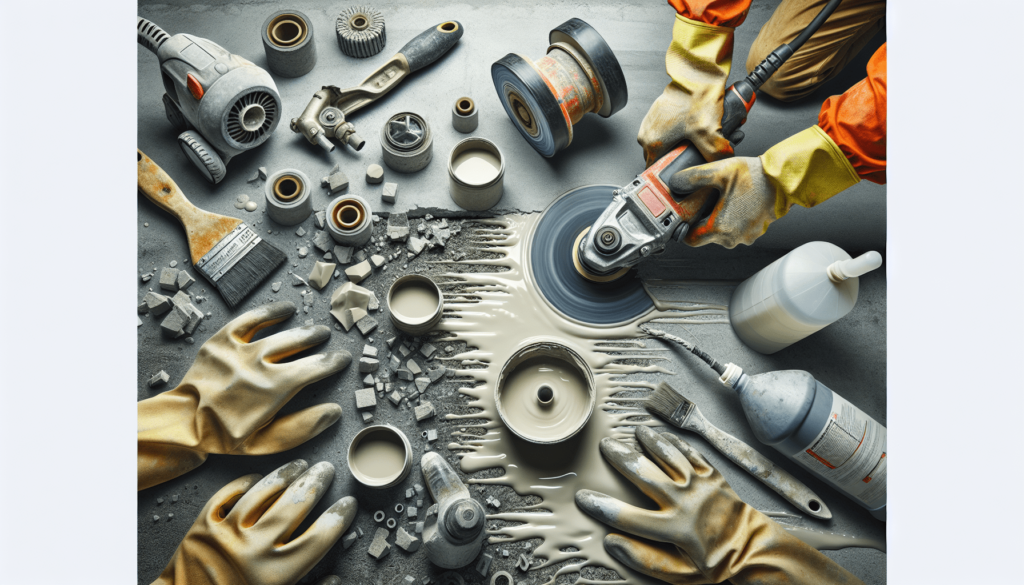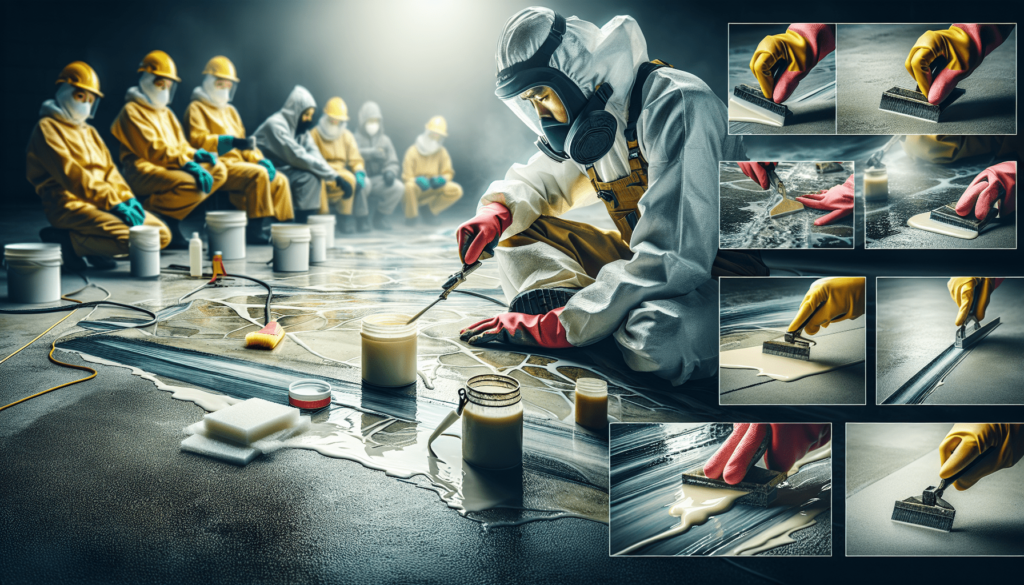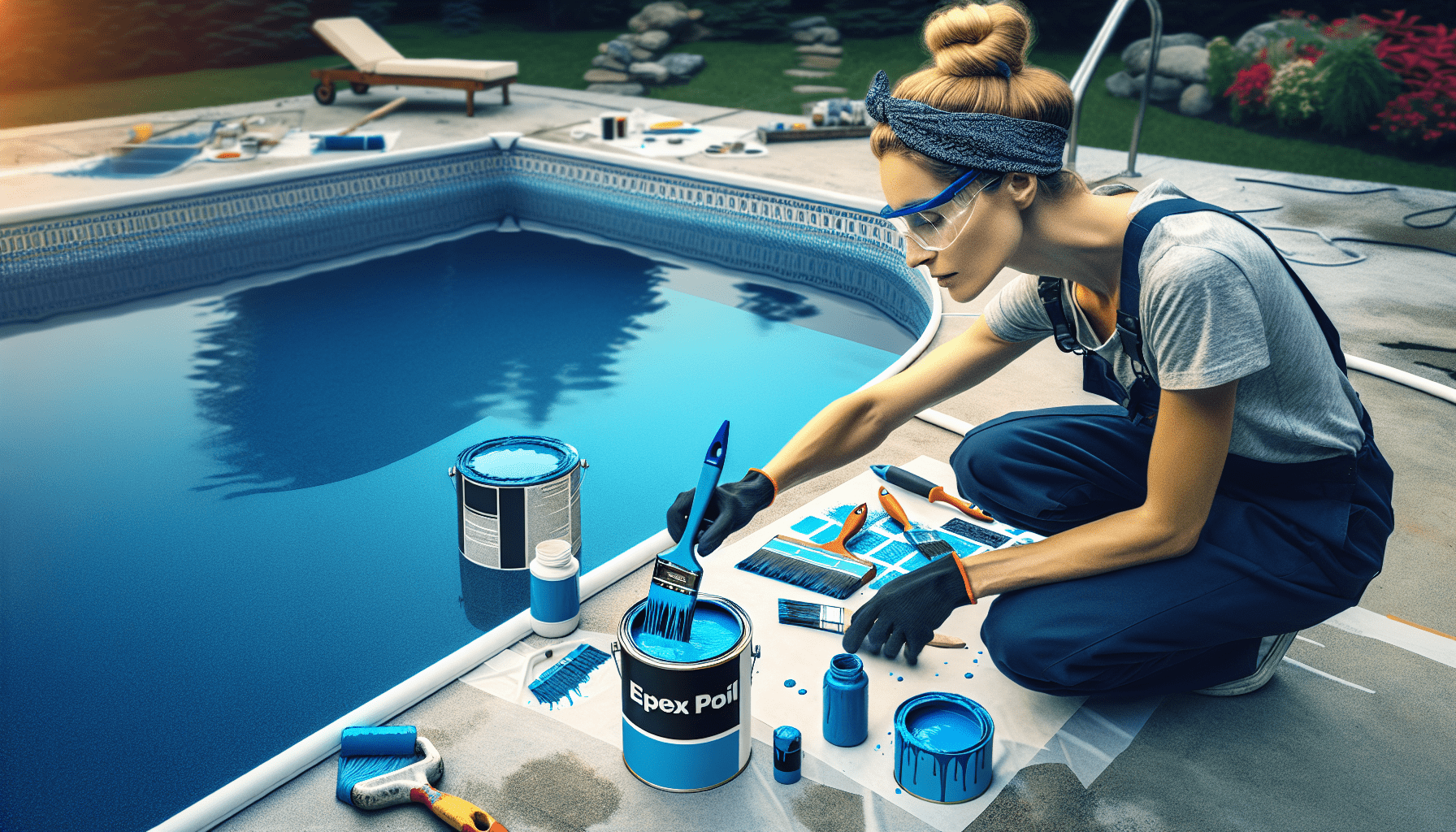In today’s article, we will explore a methodical approach to efficiently remove epoxy paint from concrete surfaces. Epoxy paint has long been favored for its durability and resistance to chemicals and stains, making it a popular choice for coating concrete floors and walls. However, over time, the need may arise to remove or replace this coating. Whether you are embarking on a remodeling project or simply seeking to restore the original appearance of your concrete surface, this comprehensive guide will provide you with effective techniques to successfully remove epoxy paint. Read on to discover the step-by-step process that will ensure a successful outcome while preserving the integrity of your concrete substrate.

Using Chemical Strippers
Choose a suitable chemical stripper
When it comes to removing epoxy paint from concrete, choosing the right chemical stripper is essential. It’s crucial to select a stripper specifically designed for removing epoxy paint to ensure effective results. Look for strippers that contain strong solvents capable of breaking down the epoxy resin. Additionally, consider opting for environmentally-friendly strippers that are low in volatile organic compounds (VOCs) to minimize the impact on the environment.
Prepare the area
Before applying the chemical stripper, it’s important to properly prepare the area to avoid any potential damage or hazards. Start by removing any furniture, objects, or debris from the surface. Protect nearby surfaces and garden areas by covering them with plastic sheets or tarps. Ensure proper ventilation by opening windows or using fans to circulate the air.
Apply the stripper
Carefully follow the instructions provided by the manufacturer when applying the chemical stripper. Typically, you would pour the stripper onto the epoxy painted surface, ensuring a thorough and even coverage. It’s essential to wear protective gloves and eyewear during this process to avoid direct contact with the stripper.
Scrub the surface
After allowing the stripper to penetrate and loosen the epoxy paint, use a stiff brush or scrubbing pad to agitate the surface gently. Scrub in circular motions to dislodge the softened paint from the concrete. Be careful not to apply excessive force, as it may cause damage to the underlying concrete.
Neutralize and clean the area
Once the epoxy paint has been successfully removed, neutralize the stripper by following the manufacturer’s instructions. This usually involves using a neutralizing agent or rinsing the area with a mixture of water and mild detergent. Thoroughly clean the surface using a pressure washer or a mop and bucket. Ensure that all traces of the stripper and epoxy paint are completely removed, leaving the concrete ready for further treatment or a fresh coat of paint.
Mechanical Methods
Scraping
Scraping is a labor-intensive but effective mechanical method for removing epoxy paint from concrete surfaces. Using a wide putty knife or paint scraper, carefully scrape away the hardened paint layer by layer. Take caution not to scratch or damage the underlying concrete while scraping. This method works best for smaller areas or stubborn spots that cannot be easily removed using other techniques.
Sanding
Sanding the epoxy paint off the concrete surface is another mechanical method that requires specialized equipment such as a floor sander or a handheld sanding machine. Start with a coarse-grit sandpaper to remove the majority of the paint, then progress to finer grits to achieve a smoother finish. Remember to wear a dust mask and protective eyewear during sanding to prevent the inhalation of paint particles.
Grinding
For larger areas or more significant epoxy paint removal, grinding is an efficient mechanical method. Rent or purchase a concrete grinder with diamond-embedded grinding discs that can effectively grind away the epoxy paint. Take proper precautions and wear protective gear, including a dust mask, safety goggles, and ear protection. It’s important to note that grinding may produce a significant amount of dust, so ensure proper ventilation or use a dust extraction system.
High-Pressure Washing
Rent or purchase a pressure washer
High-pressure washing is a popular method for removing epoxy paint from concrete due to its efficiency and effectiveness. Rent or invest in a pressure washer capable of generating high water pressure to effectively strip off the paint. Consider the size of the concrete surface and the level of paint adhesion when selecting the appropriate pressure washer.
Prepare the area
Before using the pressure washer, prepare the area by removing any loose debris or objects. Cover nearby surfaces or delicate plants with plastic sheets or tarps to protect them from the high-pressure water spray. It’s crucial to wear protective gear, including safety goggles and non-slip shoes, to ensure personal safety during the process.
Wash the surface
Starting from one end of the concrete surface, use the pressure washer to spray water at high pressure. Slowly move the nozzle back and forth, focusing on the areas with epoxy paint. The high-pressure water should effectively strip away the paint, revealing the concrete underneath. If necessary, adjust the nozzle or use different spray tips to achieve the desired pressure and coverage.
Repeat if needed
In some cases, a single round of high-pressure washing may not completely remove all the epoxy paint. If there are any remaining patches or stubborn areas, repeat the process until the concrete is completely free of paint. Take breaks in between to assess the progress and avoid causing any damage to the concrete from excessive pressure.
Heat Guns
Choose a suitable heat gun
Heat guns can be a valuable tool for removing epoxy paint from concrete surfaces. Ensure that the heat gun you choose has adjustable temperature settings to suit the specific needs of epoxy paint removal. High temperatures can soften the paint, making it easier to scrape off, while lower temperatures may be suitable for more delicate or fragile surfaces.
Prepare the area
Before using a heat gun, it’s crucial to adequately prepare the area. Remove any flammable materials or objects nearby to minimize the risk of fire or accidents. Ensure good ventilation by opening windows or using fans to disperse any fumes that may be released during the process. Also, wear appropriate protective gear, including heat-resistant gloves and safety glasses.
Apply heat to the epoxy paint
Hold the heat gun approximately 6-8 inches away from the epoxy painted surface and apply heat evenly. Move the heat gun in a slow and steady motion to heat the paint until it softens and begins to bubble or blister. Avoid leaving the heat gun in one spot for too long to prevent overheating and potential damage to the concrete.
Scrape off the softened paint
Once the epoxy paint has softened, use a putty knife or paint scraper to gently scrape off the softened paint. Work in small sections, applying gentle pressure to avoid scratching or gouging the concrete while removing the paint. It may be necessary to repeat the heating and scraping process in stubborn or larger areas.
Clean the area
After removing the epoxy paint, clean the area by wiping it down with a damp cloth or sponge to remove any residue or debris. Ensure that the concrete surface is completely dry before proceeding with any further treatments or applying a new coating.

Chemical Solvents
Choose a suitable solvent
Chemical solvents can effectively soften and remove epoxy paint from concrete surfaces. Select a solvent specifically designed for epoxy paint removal and follow the manufacturer’s instructions for safe and effective use. It’s important to note that some solvents may produce strong fumes, so proper ventilation and personal protective equipment are necessary.
Prepare the area
Prepare the area by removing any objects, furniture, or loose debris from the surface. Protect adjacent surfaces and vegetation by covering them with plastic sheets or tarps. Ensure good ventilation by opening windows or using fans to circulate the air. Additionally, wear chemical-resistant gloves, safety goggles, and a respirator to protect yourself from any harmful fumes.
Apply the solvent
Carefully pour or spray the solvent onto the epoxy painted surface, ensuring even coverage. Allow the solvent to penetrate the paint and soften it according to the manufacturer’s instructions. Take caution to avoid direct contact with the skin or eyes while applying the solvent. It’s also advisable to work in smaller sections to prevent the solvent from evaporating before it can effectively soften the paint.
Scrub or scrape the softened paint
Once the epoxy paint has sufficiently softened, gently scrub or scrape the surface using a stiff brush, scrubbing pad, or a putty knife. Work in circular motions to dislodge the softened paint and remove it from the concrete surface. Take care not to apply excessive pressure or force that could damage the concrete beneath the paint.
Clean the area
After removing the epoxy paint, thoroughly clean the area with a mild detergent solution and water. Rinse the surface to ensure that all traces of the solvent and paint are completely removed. Allow the concrete to dry before proceeding with any further treatments or applying a new coating.
Polymer Sealants
Choose a suitable polymer sealant
Polymer sealants can be used to effectively remove epoxy paint from concrete surfaces. Select a polymer sealant specifically designed for paint removal and follow the manufacturer’s instructions carefully. Look for sealants that are water-based, environmentally-friendly, and low in VOCs to minimize any negative impact on the surroundings.
Prepare the area
Before applying the polymer sealant, prepare the area by removing any objects or loose debris from the surface. Protect adjacent surfaces by covering them with plastic sheets or tarps. Wear appropriate personal protective equipment, including gloves and safety goggles, to ensure personal safety.
Apply the sealant
Apply a generous layer of the polymer sealant onto the epoxy painted surface, ensuring complete coverage. Allow the sealant to penetrate and soften the paint according to the manufacturer’s instructions. It’s important to work in smaller sections to prevent the sealant from drying before it can effectively loosen the paint.
Scrape off the sealant and epoxy paint
Once the paint has been sufficiently softened by the polymer sealant, use a putty knife or paint scraper to gently scrape off the sealant along with the softened paint. Take care not to apply excessive pressure or force that could damage the underlying concrete. Repeat the process as needed until the paint has been completely removed.
Clean the area
After removing the paint, clean the area by wiping it down with a damp cloth or sponge to remove any residue or debris. Allow the concrete surface to dry thoroughly before proceeding with any further treatments or applying a new coating.

Citric Acid
Prepare a citric acid solution
Citric acid can be an effective natural alternative for removing epoxy paint from concrete. Prepare a solution by mixing citric acid powder with warm water according to the manufacturer’s instructions. Ensure that the solution is well-mixed and dissolved.
Apply the solution to the epoxy paint
Using a brush or sprayer, apply the citric acid solution to the epoxy paint, ensuring complete coverage. Allow the solution to penetrate and react with the paint for the recommended amount of time. It may be necessary to repeat the application or increase the concentration of the solution for stubborn areas.
Scrub the surface
After giving the citric acid solution enough time to react with the epoxy paint, scrub the surface using a stiff brush or scrubbing pad. Work in circular motions to agitate and dislodge the softened paint. Additionally, rinse the brush or pad regularly to prevent the transfer of paint residue back onto the surface.
Rinse and clean the area
Once the paint has been successfully removed, thoroughly rinse the area with clean water to remove any residual citric acid solution. Take care not to let the solution come into contact with glass, metal, or other sensitive surfaces, as it may cause damage. Wipe down the concrete surface with a clean cloth or sponge to remove any remaining debris or residue.
Baking Soda and Vinegar
Create a paste using baking soda and vinegar
Baking soda and vinegar can be combined to create a paste that effectively removes epoxy paint from concrete surfaces. In a bowl, mix baking soda with white vinegar until a thick paste is formed. Ensure that the ingredients are well-blended and evenly distributed.
Apply the paste to the epoxy paint
Using a putty knife or a brush, apply the baking soda and vinegar paste to the epoxy painted surface, ensuring complete coverage. Allow the paste to sit and react with the paint for a sufficient amount of time. The baking soda and vinegar will work together to soften and lift the paint from the concrete.
Scrub the surface
After the paste has had enough time to react with the epoxy paint, gently scrub the surface using a stiff brush or scrubbing pad. Work in circular motions to agitate and dislodge the softened paint. Rinse the brush or pad regularly to remove any paint residue and prevent it from transferring back onto the surface.
Rinse and clean the area
Once the epoxy paint has been effectively removed, rinse the area with clean water to remove any remaining paste or paint residue. Use a cloth or sponge to wipe down the concrete surface and ensure that it is clean and free of debris before proceeding with any further treatments or a new coat of paint.

Sandblasting
Rent or hire a sandblaster
Sandblasting is an efficient method for removing epoxy paint from concrete surfaces, but it requires specialized equipment. Renting or hiring a sandblaster is recommended to ensure proper and effective use. Make sure to carefully review the instructions provided by the rental company or the sandblaster manufacturer to ensure safety and optimal results.
Prepare the area
Before starting the sandblasting process, thoroughly prepare the area by removing any loose debris, objects, or furniture. Cover nearby surfaces or vegetation with plastic sheets or tarps to protect them from the abrasive particles. It’s crucial to wear appropriate personal protective equipment, including a dust mask, safety goggles, and ear protection, to minimize exposure to the dust and debris generated during the sandblasting process.
Sandblast the epoxy paint
Using the sandblaster, direct the stream of abrasive particles at the epoxy painted surface, moving the nozzle back and forth to ensure even coverage. The high-speed abrasive particles will effectively strip away the paint, revealing the clean concrete underneath. Take care not to stay in one spot for too long to prevent any damage to the concrete.
Clean the area
After sandblasting, thoroughly clean the area by removing any remaining abrasive particles or debris. Use a broom, dustpan, or vacuum cleaner with a HEPA filter to safely remove the dust and debris. Rinse the concrete surface with clean water to fully eliminate any traces of the sandblasting material. Allow the surface to dry completely before proceeding with any further treatments or applying a new coating.
Acetone
Use gloves and protective gear
Acetone is a powerful solvent that can effectively remove epoxy paint from concrete surfaces. However, it is highly flammable and can be harmful if it comes into contact with the skin, eyes, or respiratory system. When using acetone, ensure that you wear chemical-resistant gloves, safety goggles, and a respirator for maximum protection.
Apply acetone to the epoxy paint
Use a cloth or sponge to apply acetone directly to the epoxy painted surface, ensuring complete coverage. Allow the acetone to penetrate the paint and soften it for a sufficient period of time. It’s important to work in smaller sections to prevent the acetone from evaporating before it can properly loosen the paint.
Scrub or scrape the paint
Once the paint has softened, gently scrub or scrape the surface using a stiff brush, scrubbing pad, or putty knife. This will help dislodge the softened paint from the concrete. Take care not to apply excessive pressure or force that could damage the underlying concrete.
Clean the area
After removing the epoxy paint, clean the area with a mild detergent solution to remove any remaining acetone residue or paint particles. Rinse the surface thoroughly with clean water to ensure that all traces of the acetone and paint are completely removed. Allow the concrete to dry before proceeding with any further treatments or applying a new coating.
In conclusion, removing epoxy paint from concrete can be achieved using a variety of methods. Selecting the most suitable method depends on factors such as the size of the painted area, the level of paint adhesion, and personal preferences. Whether you choose to use chemical strippers, mechanical methods, high-pressure washing, heat guns, chemical solvents, polymer sealants, citric acid, baking soda and vinegar, sandblasting, or acetone, it is essential to follow the proper procedures and safety precautions to achieve effective and safe results. Remember to choose the appropriate tools and equipment, prepare the area adequately, and thoroughly clean the concrete surface after paint removal. With the right approach, you can successfully remove epoxy paint from concrete, restoring its appearance and preparing it for further treatments or a fresh coat of paint.



